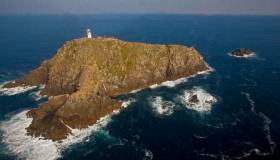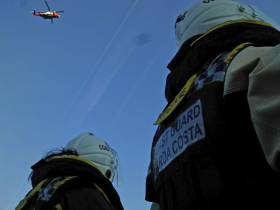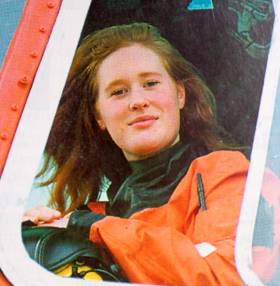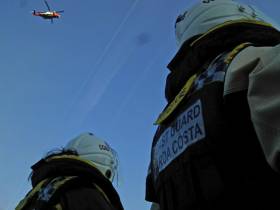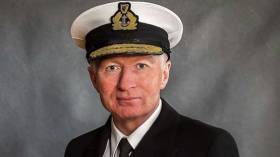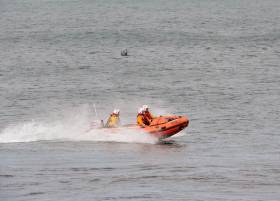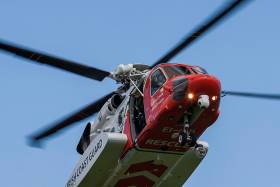Displaying items by tag: Rescue 116
#Rescue116 - Today, Wednesday 14 March, marks one year since the Rescue 116 tragedy off Co Mayo.
Relatives of the four Irish Coast Guard crew lost in the crash attended a midnight vigil in Blacksod, as The Irish Times reports.
More than 100 people joined the local community in paying tribute to Capt Dara Fitzpatrick, Capt Mark Duffy, winch operator Paul Ormsby and winchman Ciaran Smith, the latter two of whom remain missing.
Events will continue today with a Mass in Tirraunt and the laying of wreaths by the Naval Service’s LÉ Niamh and Irish Lights vessel Granuaile. The Irish Times has more HERE.
Young Scientists Hopefuls Flag Coastguard Navigation Chart Errors In Helicopter Project
#Coastguard - Secondary school students taking part in this week’s BT Young Scientist & Technology Exhibition at the RSD have identified a list of errors in navigational charts used by the Irish Coast Guard’s helicopter crews.
As the Irish Independent reports, pupils from Pobalscoil Neasáin in Baldoyle, Co Dublin found that official air charts used by the coastguard had inaccurate locations for famous landmarks including Fastnet Rock and Skellig Michael.
At the same time as the Irish Aviation Authority appeals to SAR pilots to assist in making corrections to its latest charts, the second-year students flagged the mistakes in the course of their research for a prototype helicopter-mounted ultrasonic sensor.
The ‘EchoCopter’ would the terrain of the aircraft’s flight path in real time, providing supplementary data alongside the built-in EGPWS system.
It’s hoped that such a device might help avoid further tragedies such as the Rescue 116 crash last March, which took the lives of four experienced coastguard SAR crew.
The Irish Independent has more on the story HERE.
SAR Pilots Asked To Help Correct Navigation Chart Revised After Rescue 116 Tragedy
#Rescue116 - The Irish Aviation Authority has appealed to SAR and other pilots to help correct its latest aeronautical chart introduced this past summer, as The Irish Times reports.
The updated visual flight rules chart was published in response to the Air Accident Investigation Unit (AAIU) highlighting issues with navigation data uncovered during their investigation of the Rescue 116 tragedy, which remains ongoing.
It’s now emerged that pilots have been encouraged to report mistakes and omissions in the new chart, which is already known to indicate a number of lighthouses in the wrong positions, among other errors.
In other news, the company that operates the Irish Coast Guard’s helicopter SAR services says its future profitability could be affected by potential legal and regulatory proceedings in the wake of the incident off Co Mayo in March this year.
The Irish Independent reports that CHC Ireland added the advisory to its latest accounts published for the Companies Registration Office.
UK Company Names Helicopter After Late Capt Dara Fitzpatrick
#Rescue116 - British SAR contractor Heli Operations has named its latest helicopter in tribute to Capt Dara Fitzpatrick, who died in the Rescue 116 tragedy earlier this year.
The Westland Sea King HAS.5, codenamed ZA116, will bear the name Dara with the full support of the Fitzpatrick family.
In a tweet with the news yesterday evening (Saturday 9 December), Dorset-based Heli Operations said it “has a long working relationship” with the Irish Coast Guard “and many of our crews worked with Capt Dara Fitzpatrick.”
Capt Mark Duffy, winchman Ciarán Smith and winch operator Paul Ormsby also died after their Sikorsky S-92 went down at Black Rock, west of Blacksod on the Mullet Peninsula, in the early hours of 14 March 2017.
The bodies of Smith and Ormsby have not been recovered, though items of their survival gear were found in late September.
#HeliOperations is delighted to announce that the Family of Dara Fitzpatrick have supported the naming of our new helicopter #ZA166 as "Dara" - #HeliOps has a long working relationship supporting #IrishCoastguard and many of our crews worked with Capt Dara Fitzpatrick. pic.twitter.com/I9ey40G2xN
— HeliOperations (@HeliOperations) December 9, 2017
Coastguard Helicopter Operators Warned Over Lifejacket Beacon Issues Years Before Rescue 116 Tragedy
#Rescue116 - Lifejackets worn by the crew of the downed Rescue 116 were not fit for purpose — and the operators of Ireland’s coastguard rescue helicopter service knew five years beforehand.
That’s according to a report set to be broadcast on RTÉ One’s Prime Time at 9.35pm tonight (Thursday 26 October), which reveals that pilots had warned management at CHC Ireland that locator beacons on supplied lifejackets were fitted too close to the GPS antenna, contrary to manufacturer’s guidelines.
“Effectively this means that the beacon could produce absolutely zero receivable transmissions,” said a 2014 safety report filed by one crew member, while another warned that “pilots are wholly exposed in the event of a ditching”.
The Air Accident Investigation Unit’s preliminary report in April recommended a review of the use of locator beacons on Mk 44 lifejackets used by the crew of Rescue 116.
The crash on 14 March caused the deaths of Capt Dara Fitzpatrick and Capt Mark Duffy. The bodies of Paul Ormsby and winchman Ciaran Smith remain lost at sea.
While the installation issue only applies to the pilots’ lifejackets, which have since been withdrawn from service, the Prime Time report will also cover documents that identify similar issues with those worn by winch crew across the Irish Coast Guard fleet.
The new revelations come after a previous Prime Time report this summer said the issue of missing data from the helicopter’s onboard warning system was flagged four years ago with senior management at CHC Ireland, which won a 10-year contract to operate the Irish Coast Guard’s helicopter SAR services in 2012.
Items Found On Mayo Beach Could Belong To Missing Rescue 116 Crew
#Rescue116 - A lifejacket and helmet washed up on a beach near Blacksod in Co Mayo this weekend may belong to one of the two missing crew from the Rescue 116 tragedy earlier this year, as RTÉ News reports.
The items, which were attached together, were discovered on the shore near An Clochar yesterday morning (Saturday 30 September).
A detailed search of the area has been hampered by poor weather, with no other items found.
Winch operator Paul Ormsby and winchman Ciaran Smith have been missing since the Irish Coast Guard helicopter went down at the island of Black Rock, west of Blacksod, on 14 March.
Capt Dara Fitzpatrick was recovered at the scene but was pronounced dead in hospital shortly after. The body of Capt Mark Duffy was recovered some days later.
Elsewhere, the body of a middle-aged man was found washed up on Inis Meáin in Galway Bay last night.
RTÉ News says the discovery comes almost a fortnight to the day after a Russian national was swept into the water while sea angling near Doonbeg, some 36km south of the Aran Islands.
There was better news for the families of two fishermen feared missing in Galway Bay overnight, as the Irish Examiner reports.
Aran Islands RNLI and the Shannon-based coastguard helicopter Rescue 115 were involved in the search last night and early this morning for the pair when they were reported overdue.
But the search was called off around 10.30am when the small fishing boat, which has suffered technical issues in “challenging” conditions, returned to port under its own power.
Rescue 115 was earlier requested for a medevac from Inis Mór to University Hospital Galway.
Coastguard Chief Speaks Of Sorrow Over Lost Colleagues Ahead Of Return From EU Secondment
#Coastguard - Irish Coast Guard director Chris Reynolds has paid tribute to the lives lost in the Rescue 116 and Kilkee tragedies ahead of his return from secondment in Somalia.
“The Coast Guard has lost five colleagues to accident and one, Daithi O’Cearbhallain, to cancer. I’ve lost six good friends,” said Reynolds, according to The Irish Sun.
“Not being at home and with my team in the Coast Guard has been very, very difficult,” he added.
“My first intention on my return in October is to visit our volunteer teams, co-ordination centres and helicopter bases to listen and understand how we will move forward.”
Reynolds was seconded to Somalia in July 2016 as part of an EU maritime security mission in the Horn of Africa.
Two months after his departure, coastguard volunteer Caitriona Lucas died during a search operation in Kilkee when her RIB capsized.
Six months later, Rescue 116 crashed at Black Rock in Co Mayo, claiming the lives of its four crew. Capt Dara Fitzpatrick and Capt Mark Duffy were recovered, but the bodies of winch men Paul Ormsby and Ciaran Smith were not found.
#Rescue - A mother and her two children were rescued from a sea cave at Silver Strand yesterday afternoon (Saturday 29 July) in a joint operation between Wicklow RNLI and the Irish Coast Guard.
The two children had got into difficulty while swimming at the popular beach south of Wicklow Head, and their mother rushed to their aid – only for the three of them to be swept into a nearby cave.
Wicklow RNLI’s inshore lifeboat was launched at 4.40pm and arrived on scene with the Dublin-based coastguard helicopter Rescue 116, which lowered a winchman onto the beach to locate the casualties.
The Wicklow lifeboat followed shortly after, and helm Graham Fitzgerald brought the rescue vessel close to shore where the lifeboat crew spotted three people and the winchman in a cave.
Weather conditions in the area were windy, with a southerly Force 4 and high breaking surf at the mouth of the cave.
After an assessment by the winchman and lifeboat helm, it was decided that the winchman would lead the casualties to the adjoining cave, as rocks at the entrance would impede getting the boat close to shore.
Once the casualties were in the other cave, the lifeboat crew brought the boat onto the beach and all three were transferred to the lifeboat along with the coastguard winchman.
The mother and her two daughters were believed to have been on a day trip to the beach when they decided to go for a swim and one of them got into difficultly. Her sister had tried to help, but also got into trouble.
The mother then entered the water to help her daughters, which resulted in all three of them ending up in the cave.
The winchman, a trained paramedic, assessed the three casualties on the lifeboat and they were brought to Wicklow Harbour, where they were given hot drinks.
Wicklow RNLI were involved in a similar rescue at Silver Stand in 2014 when the lifeboat was called out to rescue a woman who had been swept into a cave after getting into difficulty swimming.
#Rescue116 - The Commissioners of Irish Lights aids to navigation tender ILV Granuaile is to carry out a four-day ROV search operation beginning this weekend at the site of the Rescue 116 helicopter crash off Black Rock Lighthouse.
The ILV Granuaile had previously assisted in Remotely Operated Vehicle (ROV) operations following the helicopter crash, which took place on 14 March with the tragic loss of four Irish Coast Guard crew from helicopter Rescue 116. The ROV supplied from the Marine Institute will be used to conduct search and recovery efforts of the two crew members still missing.
Winch operator Paul Ormsby and winchman Ciarán Smith have been lost at sea since the incident off Mayo’s Mullet Peninsula four months ago and that also claimed the lives of Captains Dara Fitzpatrick and Mark Duffy.
An interim report investigating the incident took place in April. It is hoped that the favourable conditions for this weekend will aid a fresh search of the waters around Black Rock for the two Irish Coast Guard personnel.
Currently the ILV Granuaile is carrying out a contract for scientific research operations in waters up to 2,500 metres depth off the Irish continental shelf.
On completion of such duties en route back to Galway, ILV Granuaile will carry out ROV operations off the Co. Mayo lighthouse.
Operations will be directed by An Garda Siochána and are scheduled to begin tomorrow and conclude early next week on Tuesday 25th July.
#Rescue116 - Favourable conditions this weekend will aid a fresh search of the waters around Black Rock for the two Irish Coast Guard personnel still missing after the Rescue 116 tragedy four months ago.
Winch operator Paul Ormsby and winchman Ciarán Smith have been lost at sea since the incident off Mayo’s Mullet Peninsula on 14 March that also claimed the lives of Captains Dara Fitzpatrick and Mark Duffy.
The forecast for this weekend is expected to allow for new searches of Black Rock by the Garda Water Unit’s diving team, according to TheJournal.ie.
It’s also hoped that the search might turn up additional evidence to help with the investigation into the helicopter crash, such as one of the aircraft’s engines believed to be on the sea bed.
Earlier this week, RTÉ’s Prime Time reported that the coastguard’s helicopter operators were made aware four years ago of the absence of data on Black Rock from the fleet’s mapping computers.
It also emerged this week that the Irish Coast Guard is yet to acquire a permanent replacement for the crashed Sikorsky S-92 that flew under the Rescue 116 code, as The Times reports.


























